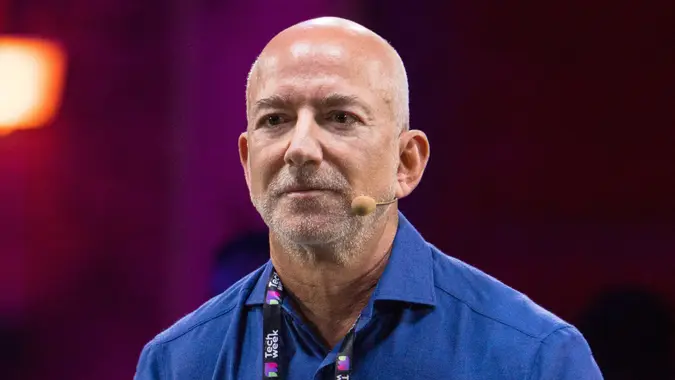4 Mistakes That Make You Feel Like You’re Living Paycheck to Paycheck, According to Ramit Sethi

Commitment to Our Readers
GOBankingRates' editorial team is committed to bringing you unbiased reviews and information. We use data-driven methodologies to evaluate financial products and services - our reviews and ratings are not influenced by advertisers. You can read more about our editorial guidelines and our products and services review methodology.

20 Years
Helping You Live Richer

Reviewed
by Experts

Trusted by
Millions of Readers
While it’s easy to come across statistics that show how many people are living paycheck to paycheck, Ramit Sethi provides various insights that suggest the opposite. It turns out people are doing better financially than what has been portrayed.
In a recent video, Sethi mentioned research that states 82% of individuals believe their finances are good or very good. Furthermore, the median American household has a $192,900 net worth and $8,000 stored in their checking and savings accounts.
Even with these optimistic data points, many people are still living paycheck to paycheck. Sethi presented common mistakes that make people feel like they have less than they really have. He also highlighted solutions that can help you feel better about your finances.
Lying To Yourself
Sethi started the video by mentioning the difference between not having enough money and making financial decisions. Some people who spend their entire paycheck each week allocate some of their cash toward tuition, a luxury car and other items.
Sethi went on to say that most people’s feelings about money do not match how they spend it. They may not feel like they have enough, but they are deploying their cash toward worthwhile expenses.
The “I Will Teach You To Be Rich” author provides an action step to address each mistake that makes you feel like you are living paycheck to paycheck. For this one, Sethi suggested creating a guilt-free spending account. After accounting for fixed costs, savings and investments, you can set aside some cash that you can spend as you wish.
This approach will allow more people to realize that they are using their hard-earned cash for discretionary expenses, which is a meaningful difference from living paycheck to paycheck.
You Don’t Have a ‘Financial Moat’
A financial moat offers a buffer of safety in case you lose your job. Sethi recommended setting up an emergency fund that covers three to six months of your expenses. For instance, if you spend $3,000 per month, you should build an emergency fund that has $9,000 to $18,000.
It’s important to keep this account separate from your checking and savings accounts. That way, you won’t mix up funds and can keep your finances more organized. Sethi’s action step for this common mistake is to gradually build your emergency savings. Even if you start at just $100 per month in your emergency savings account, it will grow over time. You can also capitalize on a high-yield savings account so your bank does some of the legwork for you.
Treating Luxury Items as Investments
Another mistake that can make you feel like you are living paycheck to paycheck is if you justify luxury purchases by claiming that they are investments. Sethi offered a clear definition of an investment: something that has the potential to produce a financial ROI.
The financial influencer mentioned a common example where the lines between luxury items and investments can get blurry. For instance, some people may assert that working with a personal trainer is an investment. As the logic goes, a personal trainer can help you get in shape and being more fit will increase your productivity and confidence.
Sethi has a personal trainer, but he doesn’t view it as an investment. A personal trainer is a luxury. The action step for luxury items is to run the numbers before buying. You have to use your income, debt, savings and other numbers to determine if you can afford a luxury.
Viewing something as a luxury instead of an investment can minimize the likelihood of overspending. It’s important to look at the cold, hard numbers instead of relying on your feelings when making decisions.
Not Being Able To Say ‘No’
The final mistake Sethi mentioned is the inability to say “no.” Saying yes to every purchase and experience can stretch your budget thin and put you in the negative. While you’re more likely to live paycheck to paycheck if you never say no, it’s an avoidable scenario.
Sethi encouraged people to get more clear on what is important to them. Knowing what’s important will also determine what isn’t important to you. Sethi said it’s okay to spend extra money on things that you enjoy, but you also have to sharply cut down on expenses for things that you don’t enjoy.
For instance, if you enjoy traveling but don’t want to attend another concert, you should use your extra money for travel and trim down on the concerts. That way, you’ll feel more fulfilled about how you spend your money and have more of it left over.
More From GOBankingRates
 Written by
Written by  Edited by
Edited by 

























